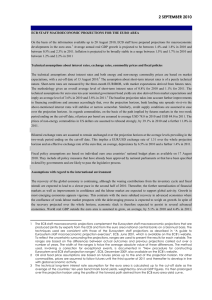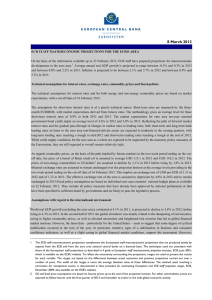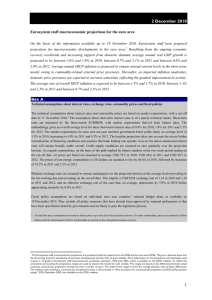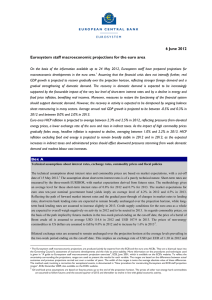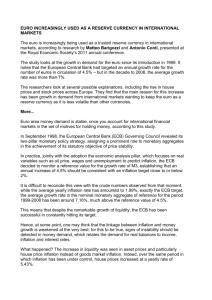5 SEPTEMBER 2013
advertisement
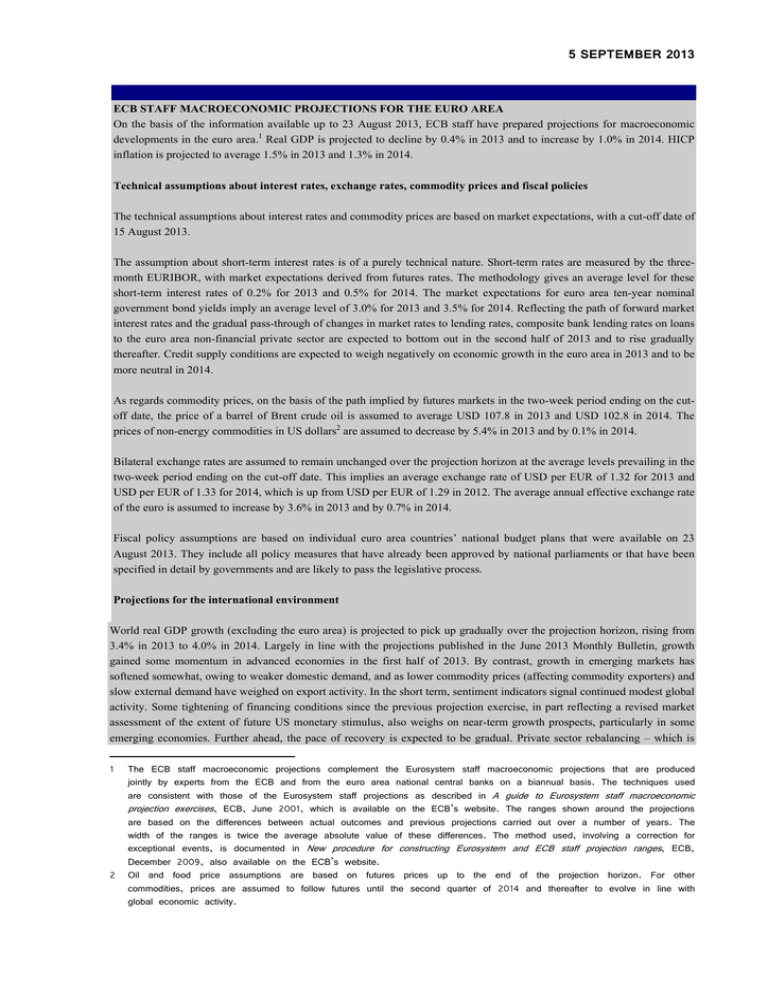
5 SEPTEMBER 2013 ECB STAFF MACROECONOMIC PROJECTIONS FOR THE EURO AREA On the basis of the information available up to 23 August 2013, ECB staff have prepared projections for macroeconomic developments in the euro area.1 Real GDP is projected to decline by 0.4% in 2013 and to increase by 1.0% in 2014. HICP inflation is projected to average 1.5% in 2013 and 1.3% in 2014. Technical assumptions about interest rates, exchange rates, commodity prices and fiscal policies The technical assumptions about interest rates and commodity prices are based on market expectations, with a cut-off date of 15 August 2013. The assumption about short-term interest rates is of a purely technical nature. Short-term rates are measured by the threemonth EURIBOR, with market expectations derived from futures rates. The methodology gives an average level for these short-term interest rates of 0.2% for 2013 and 0.5% for 2014. The market expectations for euro area ten-year nominal government bond yields imply an average level of 3.0% for 2013 and 3.5% for 2014. Reflecting the path of forward market interest rates and the gradual pass-through of changes in market rates to lending rates, composite bank lending rates on loans to the euro area non-financial private sector are expected to bottom out in the second half of 2013 and to rise gradually thereafter. Credit supply conditions are expected to weigh negatively on economic growth in the euro area in 2013 and to be more neutral in 2014. As regards commodity prices, on the basis of the path implied by futures markets in the two-week period ending on the cutoff date, the price of a barrel of Brent crude oil is assumed to average USD 107.8 in 2013 and USD 102.8 in 2014. The prices of non-energy commodities in US dollars2 are assumed to decrease by 5.4% in 2013 and by 0.1% in 2014. Bilateral exchange rates are assumed to remain unchanged over the projection horizon at the average levels prevailing in the two-week period ending on the cut-off date. This implies an average exchange rate of USD per EUR of 1.32 for 2013 and USD per EUR of 1.33 for 2014, which is up from USD per EUR of 1.29 in 2012. The average annual effective exchange rate of the euro is assumed to increase by 3.6% in 2013 and by 0.7% in 2014. Fiscal policy assumptions are based on individual euro area countries’ national budget plans that were available on 23 August 2013. They include all policy measures that have already been approved by national parliaments or that have been specified in detail by governments and are likely to pass the legislative process. Projections for the international environment World real GDP growth (excluding the euro area) is projected to pick up gradually over the projection horizon, rising from 3.4% in 2013 to 4.0% in 2014. Largely in line with the projections published in the June 2013 Monthly Bulletin, growth gained some momentum in advanced economies in the first half of 2013. By contrast, growth in emerging markets has softened somewhat, owing to weaker domestic demand, and as lower commodity prices (affecting commodity exporters) and slow external demand have weighed on export activity. In the short term, sentiment indicators signal continued modest global activity. Some tightening of financing conditions since the previous projection exercise, in part reflecting a revised market assessment of the extent of future US monetary stimulus, also weighs on near-term growth prospects, particularly in some emerging economies. Further ahead, the pace of recovery is expected to be gradual. Private sector rebalancing – which is 1 2 The ECB staff macroeconomic projections complement the Eurosystem staff macroeconomic projections that are produced jointly by experts from the ECB and from the euro area national central banks on a biannual basis. The techniques used are consistent with those of the Eurosystem staff projections as described in A guide to Eurosystem staff macroeconomic projection exercises, ECB, June 2001, which is available on the ECB’s website. The ranges shown around the projections are based on the differences between actual outcomes and previous projections carried out over a number of years. The width of the ranges is twice the average absolute value of these differences. The method used, involving a correction for exceptional events, is documented in New procedure for constructing Eurosystem and ECB staff projection ranges, ECB, December 2009, also available on the ECB’s website. Oil and food price assumptions are based on futures prices up to the end of the projection horizon. For other commodities, prices are assumed to follow futures until the second quarter of 2014 and thereafter to evolve in line with global economic activity. progressing but still incomplete – and fiscal consolidation will weigh on growth in advanced economies. The upturns in certain major emerging markets, in particular in China, are also expected to be muted as structural factors restrain activity. With demand from the euro area’s main trading partners growing at a slower pace than in the rest of the world, euro area foreign demand is somewhat weaker and is projected to grow by 2.9% in 2013, accelerating to 5.0% in 2014. Real GDP growth projections Real GDP rose by 0.3% in the second quarter of 2013, following six consecutive quarterly declines. Domestic demand and net trade contributed positively to real GDP growth in the second quarter, while the contribution of changes in inventories was slightly negative. The relatively strong increase in activity in the second quarter is to some extent explained by temporary, mostly weather-related, effects. As these temporary factors vanish, real GDP growth is expected to be lower in the third quarter of 2013, albeit remaining positive. Abstracting from the impact of these temporary factors, activity will be supported over the entire projection horizon by the favourable impact of a gradual strengthening of external demand on exports. In the shorter term, domestic demand will benefit from a drop in commodity price inflation that should support real incomes. In addition, the accommodative monetary policy stance, further strengthened by the recent forward guidance provided by the ECB’s Governing Council, and improving confidence in an environment of declining uncertainty are expected to bolster domestic demand. Beyond the short term, domestic demand is also expected to benefit from a less restrictive fiscal policy stance and the weakening of credit supply constraints. However, the adverse impact on domestic demand stemming from limited labour market developments and remaining deleveraging needs in some countries is expected to diminish only gradually over the projection horizon. Overall, the recovery is projected to remain subdued by historical standards, resulting in an output gap remaining in negative territory. In annual average terms, real GDP is expected to decline by 0.4% in 2013, largely reflecting a negative carry-over effect, before increasing by 1.0% in 2014. This growth pattern reflects a steadily rising contribution from domestic demand combined with positive but declining contributions from net trade. Considering the demand components in more detail, extra-euro area exports are projected to be modest in the remainder of 2013 and to gain somewhat more momentum in 2014, mostly reflecting the fairly gradual strengthening of euro area foreign demand. Business investment is projected to gain momentum from late 2013 onwards. The expected gradual strengthening in domestic and external demand, the very low level of interest rates, the need to gradually replace the capital stock after several years of subdued investment, less adverse credit supply effects and a strengthening of profit mark-ups as activity recovers are expected to support business investment. However, the combined adverse impact of low levels of capacity utilisation, of the need for further corporate balance sheet restructuring and of adverse financing conditions in some euro area countries and sectors is projected to diminish only gradually. Residential investment is expected to stay weak this year and next year, mostly owing to further adjustment needs in the housing markets of some countries, weak growth in disposable income, and expectations of further house price falls. The adverse impact of these factors is expected to more than offset the effect of the relative attractiveness of housing investment in some other countries, where residential investment is supported by historically low mortgage rates and rising house prices. Government investment is expected to remain weak over the projection horizon owing to the expected fiscal consolidation measures in several euro area countries. Private consumption is expected to be moderate for the remainder of the year, in the context of a flat coincident pattern of real disposable income and a broadly unchanged saving ratio. Private consumption is expected to gain some momentum in 2014, supported by a weakening of the adverse impact of fiscal consolidation and by a pick-up in labour income, as labour market conditions improve, despite a slight rise in the saving ratio. Over the projection horizon, the share of households which are expected to increase their saving ratio against the backdrop of rising disposable income and the need for deleveraging is projected to more than outweigh the share of households which continue to lower their saving ratio in an environment of falling disposable incomes and a low return on savings. Government consumption is projected to broadly stagnate in 2013, owing to fiscal consolidation efforts, and to increase modestly in 2014. Extra-euro area imports are projected to recover over the projection horizon, albeit remaining constrained by the still subdued total demand. The current account surplus is expected to increase in 2013 and 2014. 2 Table A Macroeconomic projections for the euro area 1), 2) (average annual percentage changes) HICP Real GDP Private consumption Government consumption Gross fixed capital formation Exports (goods and services) Imports (goods and services) 2012 2013 2014 2.5 1.5 1.3 [1.4 – 1.6] [0.7 – 1.9] -0.4 1.0 [-0.6 – -0.2] [0.0 – 2.0] -0.7 0.7 [-0.9 – -0.5] [-0.2 – 1.6] -0.1 0.6 [-0.6 – 0.4] [0.0 – 1.2] -3.6 1.8 [-4.4 – -2.8] [-0.7 – 4.3] 0.9 3.6 [-0.4 – 2.2] [0.1 – 7.1] -0.6 3.8 [-1.9 – 0.7] [0.3 – 7.3] -0.6 -1.4 -0.5 -4.0 2.7 -0.9 1) The projections for real GDP and its components refer to working day-adjusted data. The projections for imports and exports include intra-euro area trade. 2) Latvia is included in the projections for 2014. The average annual percentage changes for 2014 are based on a euro area composition in 2013 that already includes Latvia. Price and cost projections The headline HICP inflation rate, which in August 2013 stood at 1.3% according to Eurostat’s flash estimate, is projected to average 1.5% in 2013 and 1.3% in 2014. HICP inflation decreased markedly in the first half of 2013, owing to a strong decline in energy price inflation from its elevated levels of 2012. The drop in energy price inflation reflected in turn the decline in oil prices and the appreciation of the euro over the past year, as well as downward base effects owing to the fading away of the impact of past increases in oil prices. Looking ahead, energy prices are expected to decline somewhat over the projection horizon, reflecting the assumed path of oil prices. Over the projection horizon, the contribution of the energy component to overall HICP inflation is expected to be negligible, and thereby significantly lower than its historical average, explaining to some extent the modest profile for headline inflation. Food price inflation remained broadly unchanged in the first half of 2013, despite unusual spikes in unprocessed food prices. Looking ahead, food price inflation is expected to decline somewhat owing to downward base effects and the expected initial decline in international and European food commodity prices. HICP inflation excluding food and energy eased during the first half of 2013, reflecting weak developments in economic activity. It is expected to edge up slightly in 2014, reflecting the modest recovery in activity and increasing external price pressures. In more detail, external price pressures eased during the first half of 2013, owing to the effective appreciation of the euro and to declines in oil and non-oil commodity prices, leading to a drop in the import deflator. The latter is, however, expected to increase gradually in 2014, as the downward impact of the previous appreciation of the euro fades away, non-energy commodity prices are assumed to increase and import demand gains momentum. Turning to domestic price pressures, the annual growth rate of compensation per employee is expected to remain subdued in 2013 and 2014 on account of the weakness of the labour market. Given the projected steep decline in consumer price inflation this year, growth in real compensation per employee is expected to rise in 2013 and to continue to recover moderately over the projection horizon, following declines in 2011 and 2012. Annual growth rates of real compensation per employee are expected to remain well below those of productivity in 2014, reflecting the weakness of the labour market. Unit labour cost growth is projected to decelerate in 2013 and in 2014, as a cyclical increase in productivity growth more than offsets the small pick-up in the growth rate of compensation per employee. Following a strong decline in 2012, the profit margin indicator (as measured by 3 the ratio between the GDP deflator at basic prices and unit labour costs) is expected to stagnate in 2013, reflecting the weakness in domestic activity. Thereafter, lower unit labour cost growth and gradually improving economic conditions are expected to support a recovery in profit margins. Increases in administered prices and indirect taxes that are included in fiscal consolidation plans are expected to make significant contributions to HICP inflation in 2013 and 2014, albeit slightly less than in 2012. Comparison with the June 2013 Eurosystem staff projections Compared with the Eurosystem staff macroeconomic projections published in the June 2013 issue of the Monthly Bulletin, the projection for real GDP growth has been revised upwards by 0.2 percentage point for 2013, largely on the basis of incoming data. The projection for 2014 has been revised downwards by 0.1 percentage point, reflecting the impact of lower foreign demand, the stronger effective exchange rate of the euro and higher interest rates. The projection for headline HICP inflation has been revised upwards by 0.1 percentage point for 2013, reflecting higher than expected food prices and higher oil price assumptions. The inflation projection for 2014 remains unchanged. Table B Comparison with the June 2013 projections (average annual percentage changes) Real GDP – June 2013 2013 2014 -0.6 1.1 [-1.0 – - [0.0 – 2.2] 0.2] Real GDP – September 2013 -0.4 1.0 [-0.6 – - [0.0 – 2.0] 0.2] HICP – June 2013 HICP – September 2013 1.4 1.3 [1.3 – 1.5] [0.7 – 1.9] 1.5 1.3 [1.4 – 1.6] [0.7 – 1.9] 4 Macroeconomic projections (average annual percentage changes) a) Euro area HICP b) Euro area real GDP1) 1) The projections for real GDP refer to working day-adjusted data. Comparison with forecasts by other institutions A number of forecasts for the euro area are available from both international organisations and private sector institutions (see Table C). However, these forecasts are not strictly comparable with one another or with the ECB staff macroeconomic projections, as they were finalised at different points in time. Additionally, they use different (partly unspecified) methods to derive assumptions for fiscal, financial and external variables, including oil and other commodity prices. Finally, there are differences in working day adjustment methods across different forecasts. The ranges of the forecasts currently available from other organisations and institutions for euro area real GDP growth in both 2013 and 2014 are within the uncertainty ranges of the ECB staff projections, and close to the midpoints of the latter. As regards inflation, the range of forecasts from other organisations and institutions for HICP inflation in 2013 is slightly higher than the uncertainty range of the ECB staff projections, and also higher than their midpoint. For 2014, the range of forecasts for HICP inflation from other institutions is within the range of the ECB staff projections, and close to their midpoint. 5 Table C Comparison of forecasts for euro area real GDP growth and HICP inflation (average annual percentage changes) Date of release GDP growth HICP inflation 2013 2014 2013 2014 OECD May 2013 -0.6 1.1 1.5 1.2 European Commission May 2013 -0.4 1.2 1.6 1.5 IMF July 2013 -0.6 0.9 1.7 1.5 Survey of Professional Forecasters August 2013 -0.6 0.9 1.5 1.5 Consensus Economics Forecasts August 2013 -0.6 0.9 1.5 1.5 Euro Zone Barometer August 2013 -0.6 0.9 1.5 1.5 ECB staff projections September 2013 -0.4 1.0 1.5 1.3 [-0.6 – -0.2] [0.0 – 2.0] [1.4 – 1.6] [0.7 – 1.9] Sources: European Commision Economic Forecasts, Spring 2013; IMF World Economic Outlook Update, July 2013, for real GDP growth and World Economic Outlook, April 2013, for inflation; OECD Economic Outlook, May 2013; Consensus Economics Forecasts; MJEconomics; and the ECB’s Survey of Professional Forecasters. Notes: The ECB staff macroeconomic projections and the OECD forecasts both report working day-adjusted annual growth rates, whereas the European Commission and the IMF report annual growth rates that are not adjusted for the number of working days per annum. Other forecasts do not specify whether they report working day-adjusted or non-working day-adjusted data. 6
